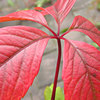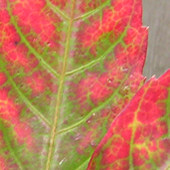23 October 2001
Opinions seem to vary on what 'preparing for winter' should involve. To be
properly wildlife friendly, it is suggested, you don't 'tidy up' the
garden, as nature doesn't tidy up in autumn. Autumn is nature's messy
season, of course.
I've been tidying up, however, and so have all the gardeners I know. This
seems to be a result of some kind of natural urge, maybe similar to the
tendencies of other creatures, as winter approaches.
Two
gardeners I know are having a 'good clear out', cutting back with
enthusiasm, digging things up and, in some cases, throwing things away.
My garden, less established than the other two gardens, has needed some
attention, and even if it didn't, I would have tackled it anyway, for my
own sake.
The
two gardeners are coping with a bereavement, as am I. We have all found
our separate gardens bring us comfort, partly because they allow us to
'keep busy' - recommended as a way of dealing with grief. Not that grief
can be 'dealt with' - like nature, it has its own seasons.
Tidying up
As
I've been cutting back and pulling up and digging up and replanting, I've
been aware of how all this work in my 'wildlife-friendly' garden disturbs
the wildlife I'm trying to give a home to. Digging disturbs and
occasionally damages earthworms. Removing the sunken reservoir of the
abandoned water feature disturbed a field mouse nest and winter store.
Numerous spiders have been dislodged, birds have been scared away from
the feeders. There I am, intruding on their peace, just because I need to
be out there.
It's a horribly unfashionable thing to say, but I have to tidy up my
garden in the autumn. Dried seedheads may feed the birds and look
beautiful when covered in frost, but I need to prepare for autumn as much
as the other creatures do. This means I work through the garden clearing
areas, cutting back. Some of this is necessary, some of it is just
therapy. I just want to be out there, occupied.
Protecting plants and pots from frost
I have to clear space in certain parts of the garden to
stand the less hardy plants that need protecting through winter. The
length of south-facing wall becomes home for many pots, which are then
further protected with horticultural fleece if necessary. Other dormant plants
that are possibly not hardy are stored in the corner near the house,
where two house walls meet. Last year I successfully overwintered some
pots of semi-tender plants by stacking the pots in this
protected corner.
In some cases, the pots themselves are more valuable to me than the
plants inside, and I have known terracotta pots crack in the frost, so
pots of hostas, for example, once they've lost their leaves, are stacked
in this corner. (This cosy corner will no doubt provide the next home for
the field mice over the winter.)
Plant highlights
Clematis tangutica - This was a resident plant when we moved in five years ago. It is one
of those venerable old clematis whose lower stems grow thick and
twisted like ropes. Its flowers first appear in late summer, and continue
through the autumn, high up, along
the top of the boundary wall, and grow through the Rowan tree with its
orange berries. The small yellow flowers amongst the orange berries formed
one of the finest garden pictures in September, and now, in October, the
plant is flowering more strongly than ever.
Nerine bowdenii - I bought 3 potted bulbs last summer, thinking that they
would flower a few months later. Obviously sold at not quite flowering
size, they produced healthy leaves but nothing else. This summer I looked
at them and wondered if they would forever be just green leaves in a pot.
I began to wonder if the jungle my garden has become means too much shade
is cast, and that bulbs like the nerine, that like baking hot sun, were
sulking through lack of light and heat. After placing them in the warmest
and sunniest spot I could find, I forgot about them.
In a rare half hour of warm sunshine last month, I dried off the garden
chair and managed to sit still for ten minutes admiring the garden. Sitting
in my chair and looking about me, I saw the potted nerine and was about
to swiftly move on and look at something else not so disappointing, when
I noticed three flowerbuds on the ends of thick stalks, apparently appeared
from nowhere while I wasn't looking. Hurrah.
Each day I watched the buds fatten and split open. There are now three
large and dramatic lipstick pink flowers. Nerine now has the prime spot
in the garden, alongside the still-flowering heliotrope.
Birds
There's a sadness for most of us in knowing the summer has gone. English
winters are so long, our summers not always warm, and always somehow too
short. Yet since I've learned about garden
birds, and their seasonal patterns, winter seems a far kinder season.
When I hear the bird calls in the autumn garden I know the birds are near,
ready to visit the winter bird table.
There are now feeders hanging from the trees for me to bang my head on
frequently in passing. Every day these are the favourite hang-out for
a lot of sparrows and blue tits, and a few great tits and coal tits. Pigeons
are an inevitable part of this, probably as we're so near a town centre.
They can be a nuisance, but I have to accept their presence. I was pleased
to see that one particular pigeon is still with us - a bird with a slightly
deformed beak who I noticed last winter. The top half of the beak overhangs
the bottom half, making it hooked (so yes, the pigeon is called Hooky).
The blackbirds are feeding
on the fallen apples. There were some apples I couldn't reach when I harvested
them, and these are now falling naturally. Also I have a large store of
smaller and damaged apples which will feed the birds over the winter.
(I should probably be turning all these apples into pies or something,
but Domestic Science lessons at school put me off cooking and baking for
life.)
Back to October highlights and diaries


